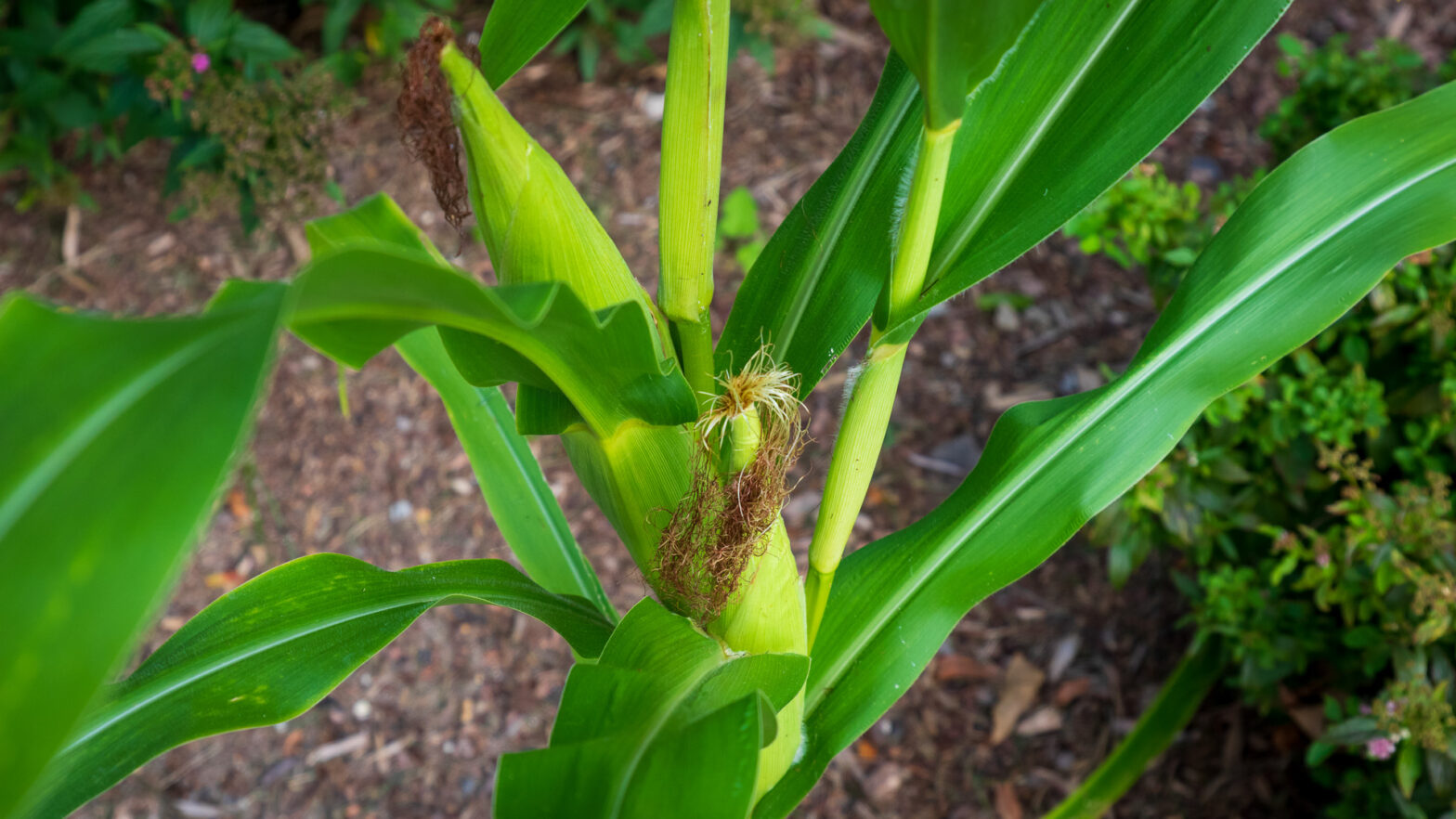I stumbled on a corn plant while maintaining a client’s garden a couple of months ago. Most people would have pulled the plant.

I love it when volunteers show up in the garden! Whether animal or vegetable, it doesn’t matter.
Nature is Random and Ordered
Nature is both random and ordered—certain plants like certain conditions. If conditions are right, those plants will grow.
In nature, plants grow in groups with some overlap. There will be fewer plants on the edge of the group than in the center. Different plants with similar requirements can grow in the same group.
Nature is not neatly sheared balls with perfect spacing and a mulch bed. Nature is quite the contrary.
Parts of a Corn Plant
Corn plants are wind-pollinated. You’ll never see a farmer grow a single row of corn. You’ll see corn growing in blocks so that the wind can spread pollen among the plants.
Wind knocks pollen off of the plant’s tassels, the male part, at the top of a corn plant.

Pollen falls onto the silk, the female part of the corn plant. There is one strand of silk for each kernel of corn.

Corn plants can have more than one ear of corn.

Where Did the Corn Plant Come From?
I would guess one of the neighbors had a bird feeder in their yard; and a raccoon, squirrel, or bird brought the corn to the garden. The animal must have missed a kernel, and it grew.
We’ve had a very wet summer with no drought—excellent conditions for corn.
I asked if it was okay to leave the corn plant when weeding the gardens in June. I forgot about it until my client sent a picture of the mature corn plant.
This photo was taken on June 30.

By August 22, the corn plant had matured.

When I gently rubbed the ears of corn, I could feel the plump, tasty kernels. I look forward to returning with the barbecue and some butter!

Comments
9 responses to “What Doesn’t Belong Here?”
The unexpected corn plant — love it, love it, and your comments!!
Thanks Ann!
So good to see a post from you again! I love the volunteer corn plant picture. I have a client who constantly has volunteer blue spruce trees popping up in their flower garden. I let them grow until they are about a foot tall and then have transplanted them to an old garden area – all doing fine so far. The greatest surprise this week was stopping at a clients to weed and deadhead when I saw the most beautiful rudbeckia growing out of the back of an Autumn Joy sedum. There has never been a rudbeckia of any kind in that flower bed. After checking types, it looks like the Indian Summer Rudbeckia in the Johnny’s seed catalog. Wish I could send a picture, it is amazing! By the way I would have left the corn also.
You should see that Dwarf Korean lilac on a standard I pruned way back this spring, it is engulfed in new growth. Should I selectively prune off a lot of the branches, or will nature take care of it? Need your great advice again!
Volunteers are one of my favorite parts of gardening. Black eyed susan has been spreading around my yard from my neighbors garden too. It’s a welcome visitor.
You have a ton of roots on that lilac and not much top growth. It’s like the plant is taking steroids. I would clean it out where the growth is too dense or growing in the wrong direction and see how things look next spring. Don’t wait too long to prune, it’s getting close to the first frost coming. Especially where you are.
Thanks John, I will get on the thinning, it will be like fighting my way thru a dense jungle. What I don’t get this Fall I will get first thing in the spring when I can better see the branch structure. Hope that will be fine?
Thanks for the thoughtful lesson, John. Always appreciate your musings.
Thanks Dana. Musing is one of the things I do best. My mind has to think about something and random plants growing in gardens are much preferred to other topics. Thanks for commenting.
John! Your post is so serendipitous! I have corn plants “popping” up all over the area where I host winter birdfeeding. First time ever. I was wondering if ears would be possible….the plants are only 2′ high so not much time left.
I love traveling plants…A potential garden bed has gone wild here all on its own…I think I might be able to pass it off as a “garden”. It really looks good….but natural:) Self-seeding/fertilizing/watering. No weeding. Gardening at its finest.
I wonder if the bird seed manufacturers changes the mix recently? I don’t see any corn in the mix I buy but I think if I get the mix for squirrels it has some corn.
I agree, ‘traveling plants’ are one of my favorite parts of gardening. It’s almost like watching a child grow when you see plants spreading in the garden. When I see plants self seeding, in modest numbers, I think to myself, “You chose the right plant and raised it right. It’s happy and spreading it’s happiness.”
That last paragraph was a little over the top but that’s the general idea.